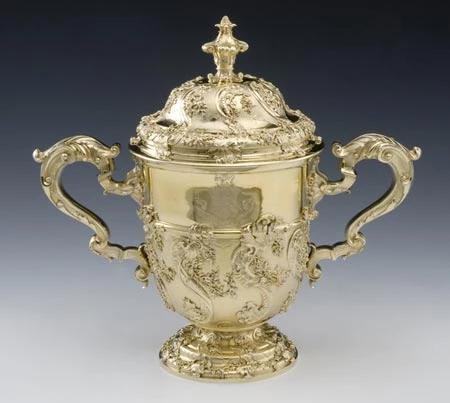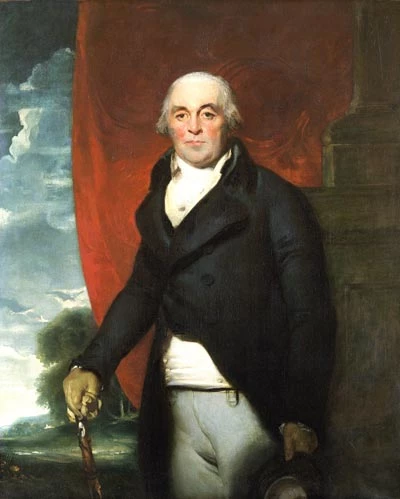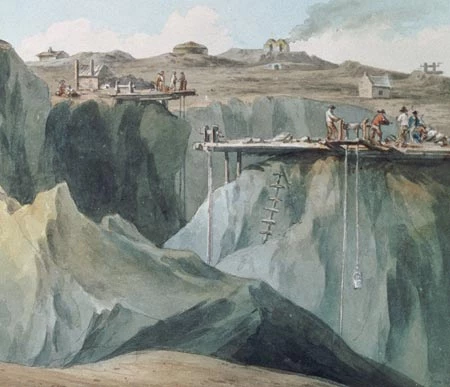A splendid silver cup for a copper magnate
Ornamental silver cup and cover
Silver Cup and Cover, Paul Crespin, 1733
Owning and displaying a large silver cup and cover was a mark of wealth and status for centuries in Britain. By 1700 such cups were no longer drinking vessels. They became entirely ornamental and a focus for the skills of their designers and makers.
William Lewis Hughes
Sir Thomas Lawrence's (1769 - 1830) portrait of Thomas Williams (1737-1802) oil on canvas; 127.5 x 102.1 cm.
A hundred years later, a particularly splendid cup made in 1733, and now in Amgueddfa Cymru, was the prized possession of one of the wealthiest men in Wales, William Lewis Hughes (1767—1835), of Kinmel Park, Denbighshire. This tells us something about a growing taste at the time for antiques, rather than the new.
The cup bears the mark of Paul Crespin, together with London marks for 1733-4. Crespin was born in 1694 into a French Protestant family. He set up business in London in 1720, and although he was recorded as bankrupt in 1747, he seems to have continued working there until 1759.
Crespin was one of the most cosmopolitan and sophisticated makers of his day. As early as 1724 he made a "curious silver vessel for bathing, which weighed about 6030 ounces" (now lost) for the King of Portugal.
He had many important clients, and his masterpiece is perhaps the celebrated "Neptune" centrepiece of 1741 in the Royal Collection, an elaborate rococo object made for Frederick, Prince of Wales.
A large silver cup
Partly because of the wealth derived from the Parys copper mine and partly because of the energetic personality of Edward Hughes, the family was to become spectacularly rich.
The cup is exceptionally large, standing 14 inches high and weighing over 150 troy ounces — a cup and cover of 1731 by Crespin's associate Abraham Buteaux and described as "large" in 1749 weighed only 94 ounces.
It is ornamented entirely in the newly fashionable rococo manner, and would have seemed quite novel. The foliage and vine decoration also appear on a pair of wine coolers made by Crespin for the Duke of Marlborough in the same year, and the double scroll handles appear a little later on cups by George Wickes, Paul de Lamerie, John Le Sage and John White.
Coat of arms
The arms of William Lewis Hughes of Kinmel. Note the arms of its original owner have been erased.
The engraving is of very high quality, remaining crisp, with little sign of surface wear. The arms of its original owner have been erased, presumably because the cup came on the market in the early 19th century. Its surface may originally have been white silver, rather than gilt. The present, rather brassy gilding is contemporary with the later armorials that can be dated to around 1830. It is interesting that the cup was 'improved' and resold in this way.
The cup's new owner was William Lewis Hughes of Kinmel. It probably came into his possession before he was raised to the peerage as Lord Dinorben in 1831, as his arms, which are engraved on both sides of the cup, have what appears to be an added Baron's coronet and lack the heraldic supporters that he was to adopt as a peer.
Parys copper mine
Junction of Mona and Parys Copper Mine as depicted in 1790.
Hughes's mother was the niece of William Lewis of Llysdulas, Anglesey. With her husband the Rev. Edward Hughes she became heir of the Llysdulas estate, which included one side of Mynydd Parys. Partly because of the wealth derived from the Parys copper mine and partly because of the energetic personality of Edward Hughes, the family was to become spectacularly rich.
The Copper King
The cup engraved ornament is of very high quality, remaining crisp, with little sign of surface wear.
William Lewis Hughes, the first Lord Dinorben, was colonel of the Anglesey Militia and MP for Wallingford from 1802 to 1831. From 1819 his London home was Bute House, South Audley Street. Edward and William Hughes were business partners of Thomas Williams, the 'copper king', whose portrait by Lawrence is also in the collections of Amgueddfa Cymru.
The cup was later owned by the Edwardian financier and philanthropist Sir Ernest Cassel (1852-1921), and was acquired by the Museum in 2005 with the support of the National Heritage Memorial Fund and the Art Fund.





